Several species of plants poisonous to livestock are distributed throughout Missouri, and many of them are commonly found in native or improved pastures. This guide describes some of the more common species that are toxic to various livestock. For more information, see your local MU Extension center, or check one of the toxic plant databases on the Web.
A common characteristic of several poisonous plants is a disagreeable taste that ordinarily discourages livestock from grazing them. Some species are poisonous only during certain stages of growth. For example, common cocklebur is most poisonous shortly before reaching the two-leaf stage. During this period of growth, cocklebur is exceedingly toxic to pigs but can also harm cattle and sheep.
If livestock poisoning is suspected, carefully examine the grazing area for poisonous plants. Jimsonweed, snow-on-the-mountain, croton and wild indigo are commonly found in open areas of the pasture. Species commonly found in shady areas include white snakeroot, bracken fern, pokeweed and buckeye. Moist areas along creeks or ditch banks are favorable for growth of water and poison hemlock, black nightshade and horsetail. Poisonous plants found in cultivated fields include cocklebur, jimsonweed, milkweed, pigweed and johnsongrass. Wild cherry, milkweed and pokeweed are found along fence and hedge rows.
What to do in case of livestock poisoning
- If you suspect poisoning, call a veterinarian immediately. If death has occurred, the stomach contents should be examined for consumed herbage.
- Identify the suspected plants. Consult your local MU Extension center or submit a plant sample:
- Plant Diagnostic Clinic
Weed Identification Service
23 Mumford Hall
Columbia, MO 65211
- Plant Diagnostic Clinic
- Remove livestock from grazing area until all poisonous plants have been destroyed.
- Eradicate poisonous plants by mowing or by applying the recommended herbicide based on the plant species present.
Common poisonous plants of Missouri
Black cherry (Prunus serotina)

- Key descriptive characteristics
It may have a tree or shrub appearance. The leaves are alternate, simple, pointed, leathery in texture and finely toothed on the margins. The bark of young branches is scaly and reddish brown with prominent cross-marks. Fragrant white flowers hang in drooping clusters and produce dark-red to black cherry fruits. - Habitat
Low or upland woods and along streams. - Distribution
All Missouri counties. - Poisonous part
Damaged or wilted leaves pose the greatest risk; all parts are potentially toxic. Hydrocyanic, or prussic, acid is the responsible toxic substance. - Symptoms
Anxiety, difficult breathing, staggering, convulsions, collapse and death may be sudden.
Black locust (Robinia pseudo-acacia)
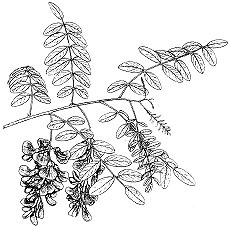
- Key descriptive characteristics
Two short, sharp spines are present at the base of each leafstalk. Leaves are alternate and pinnately compound with oval-shaped leaflets that have entire margins. The fragrant white flowers are creamy-white and arranged in long, drooping clusters. The fruit is a flat, brown pod that contains kidney-shaped beans. - Habitat
Dry or rocky upland woods, along streams, in pastures, thickets and waste ground. - Distribution
Native to the Ozarks, but present in all Missouri counties. - Poisonous part
Leaves, especially wilted leaves, young shoots, pods, seeds and inner bark contain three toxic substances: the protein robin, the glycoside robitin and the alkaloid robinine. - Symptoms
Depression, poor appetite, weakness, paralysis, abdominal pain, diarrhea and abnormal heartbeat. Death is possible.
Black nightshade (Solanum americanum)
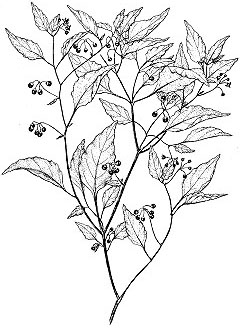
- Key descriptive characteristics
This summer annual has leaves that are alternate, simple, triangular-ovate to elliptic in shape and smooth margins. Star-shaped, white flowers, which may have tinges of purple or purple stripes, occur in clusters of 5 to 7. The fruit are small, glossy-black berries. - Habitat
Occurs in open woodland, at bases of and ledges of bluffs, along streams, fallow and cultivated fields, and along rights-of-way. - Distribution
Throughout Missouri. - Poisonous part
All parts of the plant except the mature berries contain solanine, the toxic substance. - Symptoms
Nausea, vomiting, salivation, drowsiness, abdominal pain, diarrhea, weakness, respiratory depression. Death is possible.
Bouncingbet, also known as soapwort (Saponaria officinalis)

- Key descriptive characteristics
The leaves are simple and opposite; they lack petioles and have entire margins. Bouncing bet generally grows to knee height. The flowers have a "phlox-like" appearance with white or pinkish white to red blossoms. Each flowering petal has a small notch at the tip. Seeds are reddish in color. - Habitat
Gravel and sandbars along streams, sandy or open waste ground and rights-of-way. It is seldom encountered in wooded areas. - Distribution
Throughout Missouri. - Poisonous part
The toxic substance, saponin, forms a soaplike foam when mixed with water. It is found in the leaves and stems. - Symptoms
The effects are delayed for several days. They include mild depression, vomiting, abdominal pain, and diarrhea.
Bracken fern (Pteridium aquilinum)
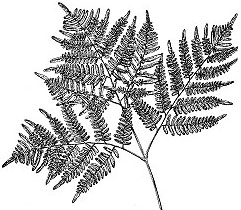
- Key descriptive characteristics
The leaves are erect and often inclined to one side. They are broadly triangular and usually divided into three sections, each with small, elongated segments. Small spore-sacs can be detected along the leaf margins. Creeping, hairy rhizomes are found underground. - Habitat
Rocky or dry open woods, favoring acidic soils. - Distribution
Primarily in the Ozark region of southern and east-central Missouri. - Poisonous part
All parts contain the toxin thiaminase. - Symptoms
Weakness, high fever, incoordination, convulsions.
Buttercups (Ranunculus spp.)
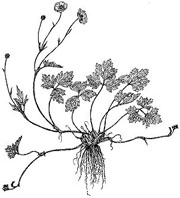
- Key descriptive characteristics
These perennial plants emerge from rootstocks or bulbs to form a rosette. Generally, the leaves are divided into three sections. The flowers occur singly and have five glossy yellow petals. - Habitat
Most species are usually in moist areas of woods and pastures. - Distribution
There are approximately 20 species of buttercups present in Missouri. Several species are found throughout the state. - Poisonous part
Leaves and stems. The toxins contained in buttercups volatilize upon drying; therefore, buttercups contained in dried hay do not pose toxicity problems. - Symptoms
The toxin causes oral and gastrointestinal irritation. Because of its immediate effects, livestock tend to avoid it.
Common cocklebur (Xanthium strumarium)
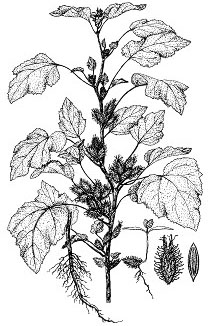
- Key descriptive characteristics
Stems contain black or red spots. The first pair of leaves are opposite and subsequent leaves are arranged alternately. Young leaves are triangular with three prominent veins. The leaves have a coarse texture, similar to sandpaper. The margins have coarse, irregular teeth. The egg-shaped burs are covered with stiff, hooked spines. - Habitat
Primarily cultivated fields, but also fallow fields, waste areas and rights-of-way. - Distribution
Throughout Missouri. - Poisonous part
The entire plant may be considered toxic; however, the young seedlings and seed contain the largest amounts of toxin. The seed bur causes mechanical injury. - Symptoms
Variable, because the plant contains several different toxins. Liver damage can result; ingestion of as little as 0.75 percent of an animal's body weight can be lethal.
Field horsetail (Equisetum arvense)
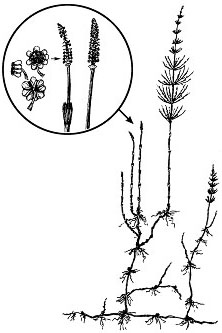
- Key descriptive characteristics
The plant has two different appearances. In the spring, single, tan-colored, jointed shoots emerge from the underground rhizome system and terminate with cone-like structures. Later, green and sterile shoots emerge and have the appearance of a horse's tail. - Habitat
Banks of streams, ditches and commonly along railroad embankments. - Distribution
Throughout Missouri. - Poisonous part
All. - Symptoms
See bracken fern; the plant contains the same toxin. Horses are most severely affected, while other grazing animals are moderately susceptible.
Jimsonweed (Datura stramonium)
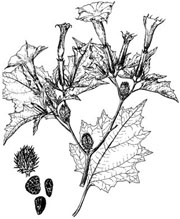
- Key descriptive characteristics
Leaves are alternate, coarsely toothed and smooth with a glossy-green appearance. The plant's foliage has a distinct, foul odor. This summer annual can grow to heights of approximately 5 feet. The tubular flowers are very showy and range in color from white to purple. Seedpods are egg-shaped and covered with prickles. - Habitat
Pastures, barnyards, cultivated fields, waste areas, rights-of-way and rocky open places. - Distribution
Throughout Missouri. - Poisonous part
Seeds contain the greatest concentration of the toxic alkaloids atropine, hyoscyamine and hyosine. Leaves contain lower concentrations of the alkaloids. Animals will avoid grazing jimsonweed; however, the alkaloids remain in dried hay. There is no reported safe quantity of hay that can be fed to livestock. - Symptoms
Signs can become readily apparent. Because the alkaloids act on the nervous system, bodily functions are affected. Animals may have dilated pupils, become agitated, have increased heart rate, tremble, become delirious, appear to be hallucinating, have convulsions, become comatose, and possibly die.
Johnsongrass (Sorghum halepense)
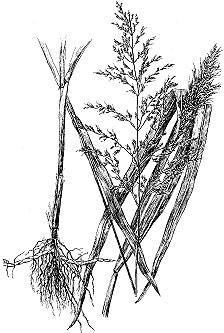
- Key descriptive characteristics
johnsongrass is a coarse perennial grass that emerges from an extensive underground rhizome system. The plant grows in dense stands, reaches heights up to 8 feet in some situations and often has reddish brown blotches on its leaves. The seed heads are large, open and loose. - Habitat
Pastures, fertile cultivated fields, rights-of-way and field borders. - Distribution
The plant has rapidly spread into many areas of the state; however, some northern counties are void of johnsongrass. - Poisonous part
Leaves and stems possess cyanide. The young shoots are the most toxic, and when wilted or frost-damaged, cyanide becomes readily available in the leaves. Nitrates can also accumulate in johnsongrass. Well-cured hay is relatively safe for animal consumption as mature plants have much lower toxicity. - Symptoms
Occur very rapidly. The animal will breathe rapidly and deeply, then become anxious and stressed. Progressing symptoms include trembling, incoordination, attempts to urinate and defecate and collapsing. Finally, respiratory or cardiac arrest may occur, leading to a violent death.
Milkweeds (Asclepias spp.)
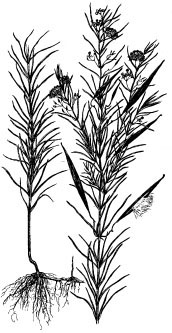
- Key descriptive characteristics
Missouri has approximately 15 species of this plant. Most have a thick, milky sap in their leaves, stems and seedpods. The plant is erect-growing and has opposite, fleshy leaves (one species has whorled leaves) with entire margins. Flowers have a "globe-like" appearance and range in color from white to purplish pink. Fruit are large, angled pods with soft spines. Seeds are a flattened oval with a winged margin and have a terminal tuft of long silky hairs. - Habitat
Fields, open woods, waste ground and rights-of-way. - Distribution
Throughout Missouri. - Poisonous part
Stems, leaves and roots contain glycosides. The sap contains a resin, known as galitoxin, which contributes to its toxicity. - Symptoms
Although not eaten under normal circumstances, muscle tremors and spasms, bloat, increased heart rate, difficult breathing, and occasionally death. Toxic signs are more apparent in animals that cannot vomit, such as horses.
Mustards (Brassica spp., Thlaspi spp. and Lepidium spp.)
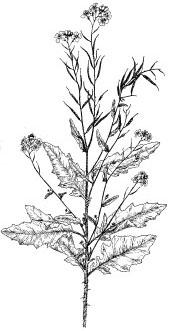
- Key descriptive characteristics
Collectively, the mustards have a pungent sulfurous odor. They tend to produce a basal rosette of leaves, and later produce alternate leaves along their stems. Most mustards have yellow flowers with four petals. Some of the common species in Missouri are wild mustard, field pennycress, tansy mustard, yellow rocket and Virginia pepperweed. - Habitat
Fields, waste ground, pastures, rocky glades and rights-of-way. - Distribution
Throughout Missouri. - Poisonous part
All parts, especially seeds contain isoallyl thiocyanates, irritant oils, and under some conditions, nitrates. - Symptoms
Oral and gastrointestinal irritation is most common leading to head shaking, salivating, colic, abdominal pain, vomiting and possibly diarrhea. Generally, for problems to occur, large quantities have to be consumed over a period of time.
Ohio buckeye (Aesculus glabra)
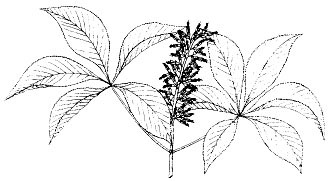
- Key descriptive characteristics
Leaves are opposite and are palmately compound consisting of five leaflets. Flowers are yellow and occur in clusters at the ends of branches. The fruit is prickly, glossy and leathery brown and has a pale scar. - Habitat
Rich or rocky woods of valleys, ravines, slopes, bases of bluffs and thickets. - Distribution
Throughout Missouri. - Poisonous part
Buds, nuts, leaves, bark, seedling and honey contain aesculin and are thought to contain alkaloids. - Symptoms
Both gastrointestinal and neurologic. Gastrointestinal signs occur first, with salivation, vomiting, abdominal pain and diarrhea. If enough of the toxin was ingested, neurological signs may develop, including trembling, staggering and difficult breathing.
Poison hemlock (Conium maculatum)
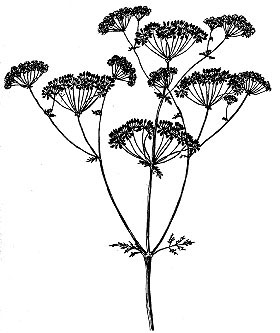
- Key descriptive characteristics
This biennial has smooth, purple-spotted stems that are hollow. The leaves are pinnately compound, highly divided with very small leaflets giving the plant a fernlike appearance. The white flowers occur in umbels (umbrella-like) and closely resemble Queen Ann's Lace, a close relative. - Habitat
Fields, pastures, fence rows, waste ground and rights-of-way. - Distribution
Throughout Missouri. - Poisonous part
All parts contain the toxic alkaloid, coniine and others. - Symptoms
Salivation, vomiting, diarrhea, weakness, paralysis, nervousness, trembling, dilation of pupils, weak pulse, convulsions and coma.
Common pokeweed (Phytolacca americana)

- Key descriptive characteristics
Stems and petioles are reddish in color. Leaves are alternate, egg-shaped, smooth and glossy in appearance. The plant is a perennial; regrowth occurs from a large, fleshy taproot. The plant produces clusters of purple to black berries that contain a reddish juice and 10 seeds. - Habitat
Waste areas, farm lots, fencerows, thickets and borders of woods. - Distribution
Throughout Missouri. - Poisonous part
All parts, especially roots and seeds. - Symptoms
Irritant effects due to phytolaccigenin are salivation, abdominal pain and diarrhea. In rare cases where large doses are consumed, animals may show anemia and alterations in heart rate and respiration.
Snow-on-the-mountain (Euphorbia marginata)
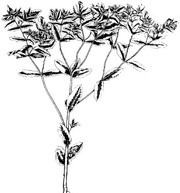
- Key descriptive characteristics
This summer annual has alternate leaves with the upper leaves having a white margin. Flowers are very showy and white. The plant contains a milky sap. - Habitat
Dry, hot and clayey soils, fields, pastures and rights-of-way. - Distribution
Scattered; it is a native of the loess hills of northwest Missouri. - Poisonous part
All parts. - Symptoms
Nausea, vomiting and diarrhea. The toxins are diterpene esters contained in the milky sap of the plant.
Water hemlock (Cicuta maculata)
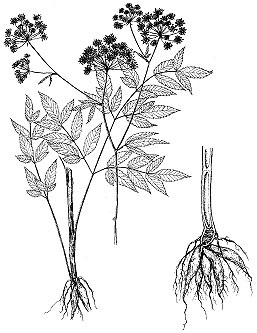
- Key descriptive characteristics
This perennial plant has tuberous, fleshy roots and purple-mottled, hollow stems. The leaves are alternate and two to three pinnately divided. Flowers are small and white and occur in umbrella-like clusters. - Habitat
Along borders of ponds, sloughs, ditches, streams and wet depressions of pastures. - Distribution
Throughout Missouri. - Poisonous part
All parts, especially the roots. - Symptoms
Muscle spasms, dilated pupils, dizziness, diarrhea, abdominal pain and convulsions. Reportedly, a walnut-sized portion of the root is sufficient to kill a cow.
White snakeroot (Eupatorium rugosum)
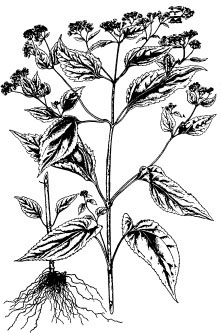
- Key descriptive characteristics
The plant is a perennial that regrows from roots. It has opposite, oval leaves that are finely toothed along the margins and pointed at the tip. The plant grows to a height of 4 to 5 feet. It produces small, white flowers in the late summer. - Habitat
Rich or rocky woods, at the bases and crevices of bluffs, rock outcrops and thickets. - Distribution
Throughout Missouri. - Poisonous part
Leaves and stems; roots have lower toxicity. - Symptoms
The toxic component is tremetol and the toxic dose of the green plant is 1 to 10 percent of the animal's body weight. The onset of signs ranges from two days to three weeks, with depression, stiff gait, muscle tremors, trembling, partial throat paralysis, jaundice, passage of hard feces and prostration. Death may be sudden with no prior signs of toxicity. Because tremetol is excreted in the milk, nursing animals will be affected by the toxin.
Wild indigo (Baptisia spp.)
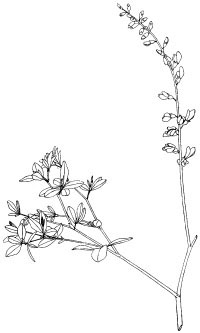
- Key descriptive characteristics
Leaves are alternate and three-parted; the plant has a shrublike growth habit. Flower color varies and depends on species. The most striking characteristic of this perennial plant is the seedpods. They are inflated and occur on stalks containing several seeds. - Habitat
Prairies, glades, rocky open slopes, alluvial soils along streams and wet pastures. - Distribution
Throughout Missouri. - Poisonous part
All parts. - Symptoms
Nausea, vomiting and diarrhea. The plant contains baptisin and cytisine, which are moderately toxic if eaten.
Woolly croton (Croton capitatus)

- Key descriptive characteristics
This summer annual is short and erect in stature. It has brown stems that are covered with hairs. The leaves are alternate, simple and hairy. The fruit is a three-lobed capsule. - Habitat
Most commonly, the plant is found in sandy open ground, fallow fields and pastures. - Distribution
Throughout Missouri. - Poisonous part
All parts. - Symptoms
Cattle are poisoned by the croton oil contained in the plants. It is toxic only if large quantities are consumed. Vomiting, diarrhea and nervousness are primary symptoms.
Line drawings of black cherry (Prunus serotina), black locust (Robinia pseudo-acacia), Ohio buckeye
(Aesculus glabra), and wild indigo (Baptisia leucantha) are reprinted, with permission, from Julian A. Steyermark's Flora of Missouri (1963, Missouri Department of Conservation).